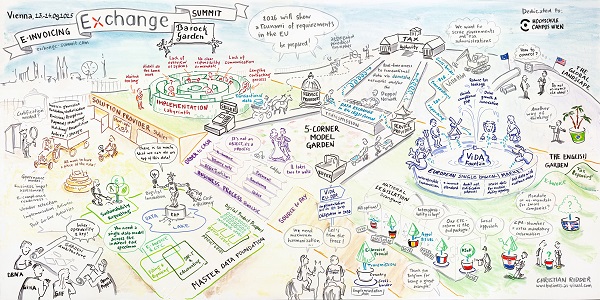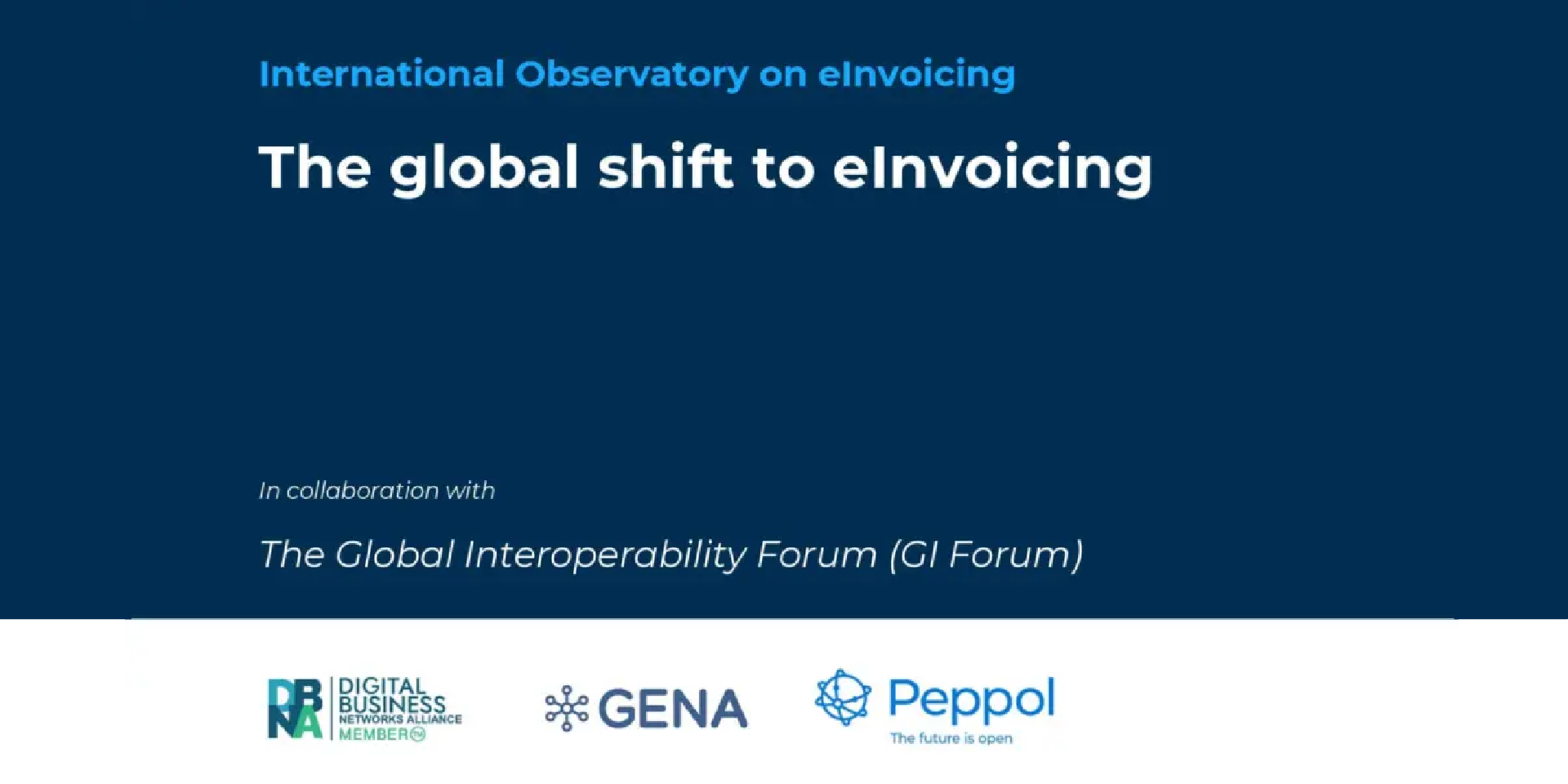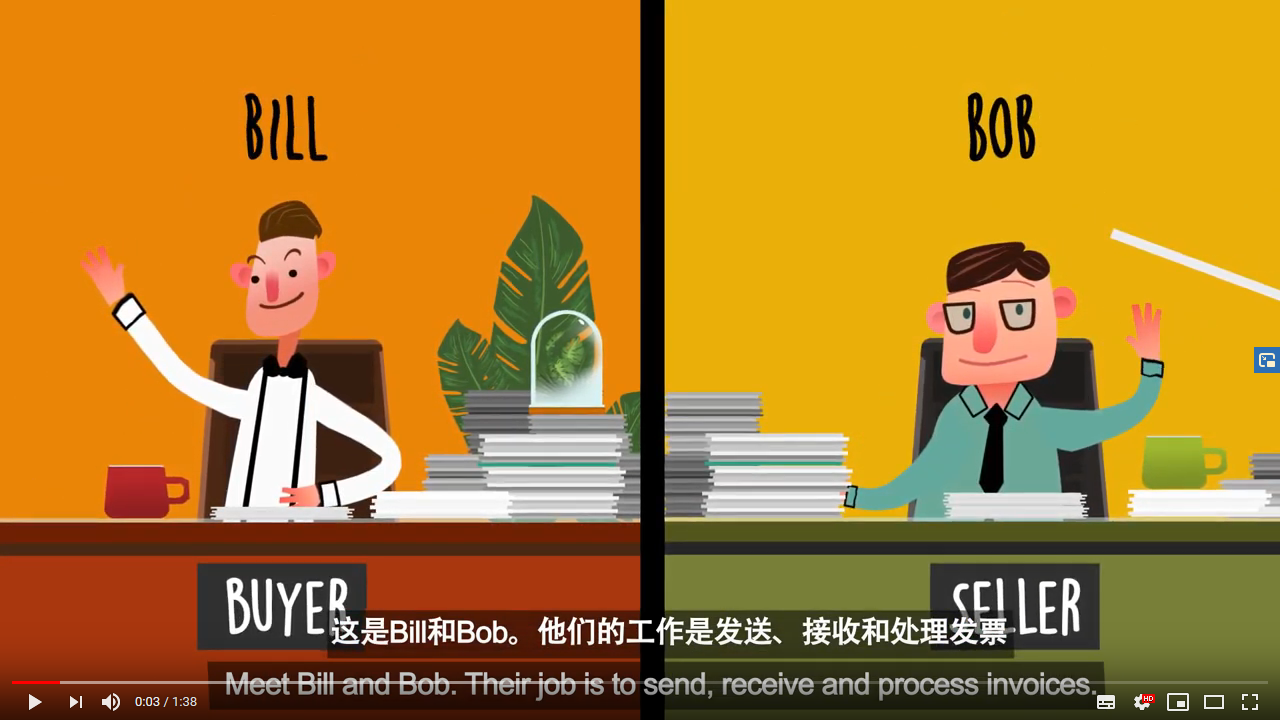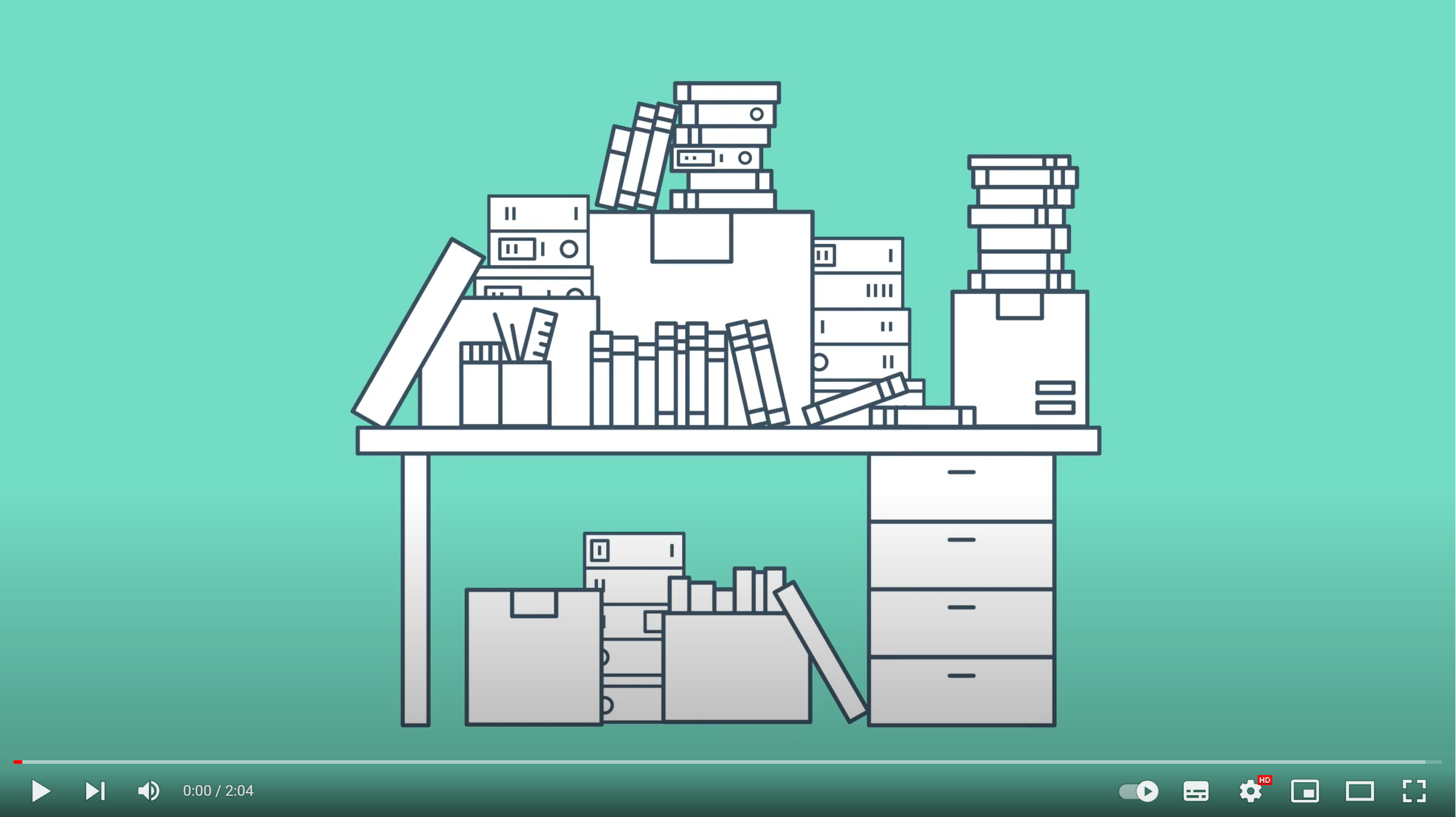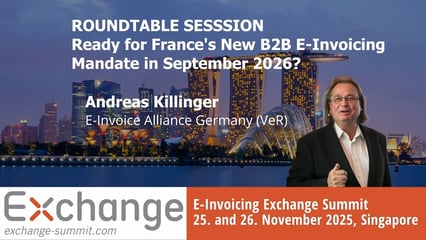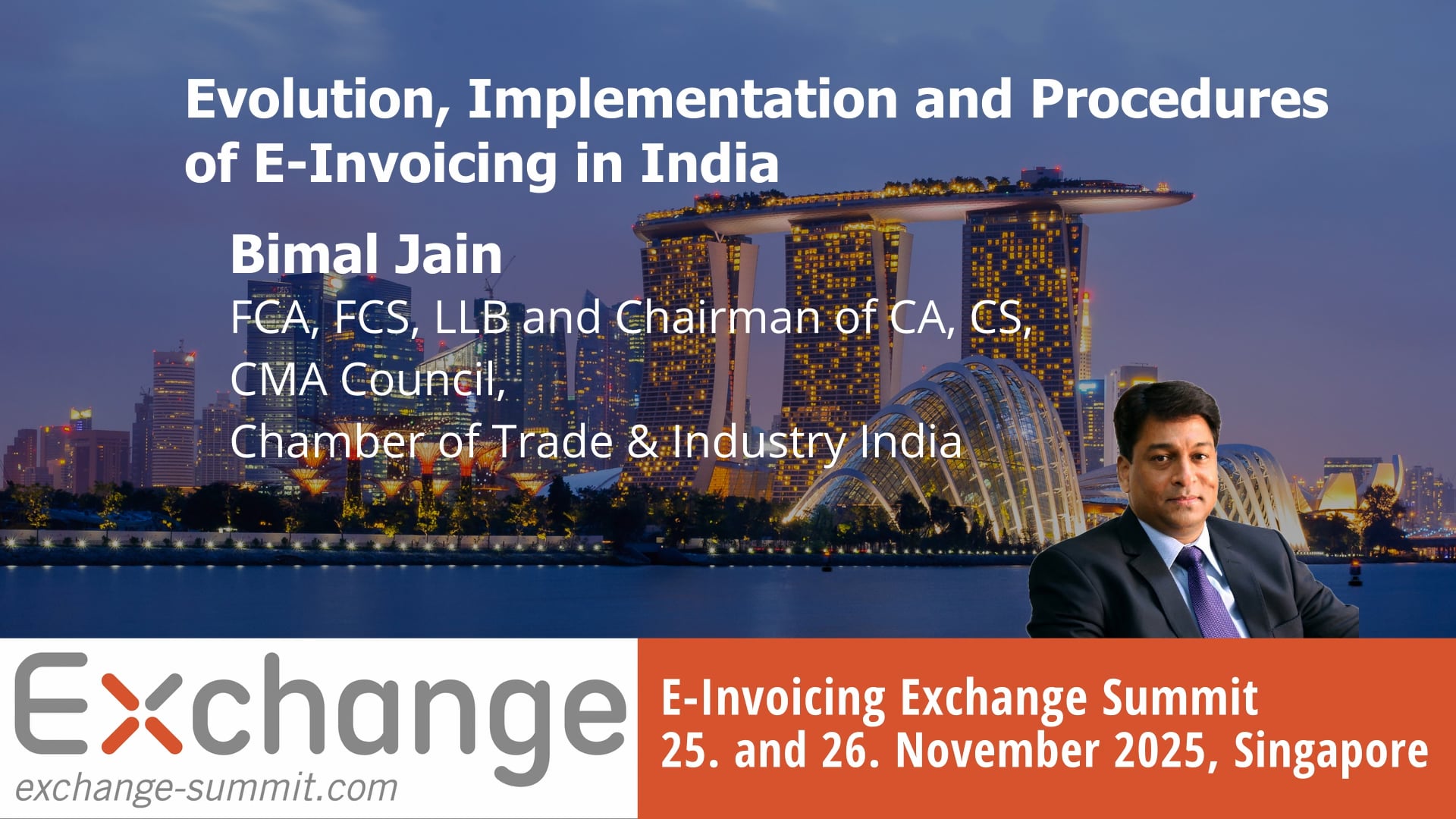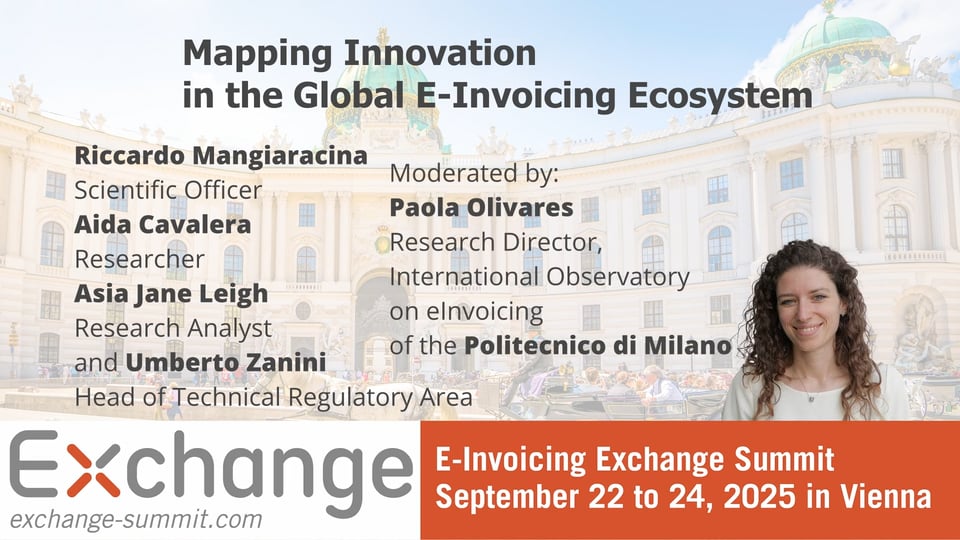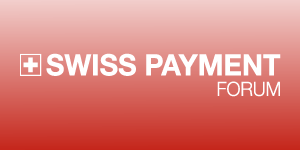E-Invoicing Glossary
| # | |
| 3-Corner Model | 3-Corner Model is an exchange model where senders and receivers of invoices are connected to a single service provider for the dispatch and receipt of messages. Another definition: 3-Corner Model is an invoicing process set-up whereby trading partners have separate contractual relationships with the same service provider. When both senders and receivers of invoices are connected to a single hub for the dispatch and receipt of invoices, it is referred to as a 3-Corner model. This central hub consolidates the invoices of several receivers and many senders in the case of accounts payable, and several senders and many receivers in the case of accounts receivable processing. Consolidators and trade platforms are usually 3-Corner Models in which both senders and receivers are connected to the service. The 3-Corner Model in principle can only offer reach to the parties that are connected to the central hub. This means that either invoice senders or invoice |
| 4-Corner Model | 4-Corner Model is an exchange model where senders and receivers of invoice messages are supported by their own service provider. Another definition: 4-Corner Model is an invoicing process set-up whereby each trading partner has contracted with one or several separate service providers, whereby the service providers ensure the correct interchange of invoices between the trading partners. The concept of the 4-Corner model originated in the banking sector. When senders and receivers of invoices are supported by their own consolidator service provider (for the sender) and aggregator service provider (for the receiver), it is referred to as a 4-Corner Model. A network usually based on open standards provides connectivity and the facilities for the secure trusted exchange of invoices and or other business documents. In the 4-Corner Models, the consolidator and aggregator roles are often two different service providers. |
| A | |
| Access to finance | Access to finance is the ability of individuals or enterprises to obtain financial services, including credit, deposit, payment, insurance and other risk management services. |
| Accounts payable (A/P) | Accounts payable refers to the money a business owes to others; current liabilities incurred in the normal course of business as an organisation purchases goods or services with the understanding that payment is due at a later date. Accounts payable is also the department within an organisation responsible for paying invoices on behalf of the organisation. |
| Accounts payable automation | Accounts payable automation represents the (semi-) automated management of accounts payable administration by automated processing of invoices. Accounts payable automation requires integration of the invoicing process with accounting software. |
| Accounts receivable (A/R) | Accounts receivable refers to money which is owed to a company by customer for products and services provided on credit. This is often treated as a current asset on a balance sheet. A specific sale is generally only treated as an account receivable after the customer is sent an invoice. |
| Advanced electronic signature (AES) | Advanced electronic signature (AES) means an electronic signature which meets the following requirements: a) it is uniquely linked to the signatory; b) it is capable of identifying the signatory; c) it is created using means that the signatory van maintain under its sole control; and d) it is linked to the data to which it relates in such a manner that any subsequent change of the date is detectable. |
| Aggregators | Service Bureaus that provide Billing and/or Payment ConsolidationServices. |
| Alternative finance | Alternative financial services (AFS) is a term often used to describe the array of financial services offered by providers that operate outside of federally insured banks and thrifts (hereafter referred to as ‘banks’). Check-cashing outlets, money transmitters, car title lenders, payday loan stores, pawnshops and rent-to-own stores are all considered AFS providers. However, many of the products and services they provide are not ‘alternative’; rather, they are the same as or similar to those offered by banks. AFS also sometimes refers to financial products delivered outside brick-and-mortar bank branches or storefronts through alternative channels, such as the internet, financial services kiosks and mobile phones. Online platform-based alternative financing activities include donation-, reward- and equity-based crowdfunding, peer-to-peer consumer and business lending, invoice trading, debt-based securities and others. |
| ASP - Application Service Provider | Third party vendor used by seller to outsource the presentment of electronic invoices. |
| Asset based lending (ABL) | Asset based lending (ABL) is a specialised form of secured lending whereby a company uses its current assets (accounts receivable and inventory) as collateral for a loan. The loan is structured so that the amount of credit is limited in relation to the value of the collateral. The product is differentiated from other types of lending secured by accounts receivable and inventory by the lender's use of controls over the borrower’s cash receipts and disbursements and the quality of collateral rather than ownership of the receivables as in factoring. |
| Asset based loan | Asset based loan is a business loan in which the borrower pledges as loan collateral any assets used in the conduct of his or her business. Funds are used for business-related expenses. All asset- based loans are secured. |
| Authentication | The process of verifying the identity of a user of a secure system. Also, used to verify the integrity of a message. This is often through the use of ID's and passwords. |
| Automated clearing house (ACH) | Automated clearing house (ACH) is an electronic payments system (outside the card networks) for clearing and settling transactions. Funds are electronically exchanged directly to/from participants’ accounts. Frequently used by end-user organisations as the payment method by which to pay their issuer. |
| B | |
| B2A | Business to Administration |
| B2B | Business to Business; Traffic to enterprise payers, government etc. (via Web Browser or EDI-Download and Import in the ERP-system); invoices have to be VAT compliant |
| B2C | Business to Customer; Traffic to consumers (via Web browser or EDI-Download and Import in the PFM-system) |
| B2G | Business-to-government |
| Bank payment obligation (BPO) | Bank payment obligation (BPO) is a class of settlement solution in international supply chain finance. Bank payment obligation is an irrevocable undertaking given by an obligator bank (typically buyer’s bank) to a recipient bank (usually seller's bank) to pay a specified amount on an agreed date under the condition of successful electronic matching of data according to an industry- wide set of rules adopted by International Chamber of Commerce (ICC) Banking Commission. |
| Basel III | Basel III is a comprehensive set of reform measures designed to improve the regulation, supervision and risk management within the banking sector. The Basel Committee on Banking Supervision published the first version of Basel III in late 2009, giving banks approximately three years to satisfy all requirements. Largely in response to the credit crisis, banks are required to maintain proper leverage ratios and meet certain capital requirements. |
| Bill of lading | A bill of lading (sometimes abbreviated as B/L or BoL) is a legal document between the shipper of a particular good and the carrier detailing the type, quantity and destination of the good being carried. The bill of lading also serves as a receipt of shipment when the good is delivered to the predetermined destination. This document must accompany the shipped goods, no matter the form of transportation, and must be signed by an authorised representative from the carrier, shipper and receiver. |
| Bill/Invoice Detail | Information from a seller that provides invoice line level information to a buyer. This may include specific invoice event information such as credit card charges, telephone calls, or kilowatts used. |
| Bill/Invoice Notification | A process whereby a buyer is notified that an electronic bill is available for review and payment. |
| Bill/Invoice Summary | The summary information from a seller that is essential to a buyer to understand what is owed. It include all VAT and payment relevant data. Typical information may include; Amount Owed, Date Due, Seller, Seller’s Account Number. Also: Summary Record, Summary, Invoice Summary, Invoice Summary Record, Bill Summary Record. |
| Biller Direct | EBPP model connecting one seller to many consumers. Consumers connect to the seller’s site to view bills. |
| Biller Service Provider (BSP) | An agent of the Biller that provides an EBPP service for the Biller. Commercial Relationship - An agreement between parties to do business together for the purpose of EBPP. It may or may not include a contract. |
| Business interoperability interfaces (BII) | Business interoperability interfaces on public procurement in Europe (BII) is CEN Workshop providing a basic framework for technical interoperability in pan-European electronic transactions, expressed as a set of technical specifications that in particular are compatible with UN/CEFACT. |
| Business networks | Many businesses use networking as a key factor in their marketing plan. It helps to develop a strong feeling of trust between those involved and play a big part in raising the profile and takings of a company. Suppliers and businesses can be seen as networked businesses, and will tend to source the business and their suppliers through their existing relationships and those of the companies they work closely with. Networked businesses tend to be open, random and supportive, whereas those relying on hierarchical, traditional managed approaches are closed, selective and controlling. |
| Business Process Outsourcing (BPO) | Business process outsourcing (BPO) is the contracting of a specific business task, such as payroll, to a third-party service provider. Usually, BPO is implemented as a cost-saving measure for tasks that a company requires but does not depend upon to maintain their position in the marketplace. |
| Business-to-business (B2B) | Business-to-business is a type of commerce transaction that exists between businesses, such as those involving a manufacturer and wholesaler, or a wholesaler and a retailer. Business to business refers to business that is conducted between companies, rather than between a company and individual consumers. This is in contrast to business to consumer (B2C) and business to government (B2G). A typical supply chain involves multiple business to business transactions, as companies purchase components and other raw materials for use in its manufacturing processes. The finished product can then be sold to individuals via business to consumer transactions. |
| Business-to-business payments | Business-to-business payments represent the payments that are made between businesses for various goods, services and expenses. |
| Business-to-consumer (B2C) | Businesses or transactions conducted directly between a company and consumers who are the end-users of its products or services. Business-to-consumer as a business model differs significantly from the business-to-business model, which refers to commerce between two or more businesses. |
| Buyer | Customer, payer |
| Buyer Direct | EIPP model connecting one buyer to many sellers. Sellers post their invoice data to the buyer's site. |
| C | |
| CA | Certification authority, a body trusted by all users to create and assign (public key) certificates |
| Card scheme | Card schemes such as Visa or MasterCard promote the use of various card types which carry their logos. Banks and financial institutions have to apply for membership of the appropriate card scheme before they can issue cards or acquire transactions. |
| Cash flow | Cash flow represents the patter n of company income and expenditures and resulting availability of cash. |
| CEFACT | Centre for Facilitation of procedures and practices for Administration, Commerce and Transport (Centre des Nations Unies pour la Facilitation des Pratiques dans l'Administration, le Commerce et le Transport) (www.unece.org/cefact/) |
| CEN | Comité Européen de Normalisation;European Committee for standardization, www.cenorm.be |
| CEN/ISSS | CEN Information Society Standardization System |
| CENBII | CENBII is an UBL-based XML format used for the OpenPEPPOL network, it currently exists in a version 1 and version 2. CENBII is meant to be used for international transfers on OpenPEPPOL, whereas domestic transfers will generally use a localised version of CENBII (e.g. EHF, SimpleInvoice). |
| CFDI | Comprobante Fiscal Digital a través de Internet (CFDI), or Digital Tax Receipt through Internet, refers to the current mandated form of e-invoicing in Mexico. All E-Invoices in Mexico are issued as CFDI as of January 1, 2014. |
| Cll | The Cross Industry Invoice (CH) is a technical specification that can be used to create message syntax that can be exchanged globally between trading partners. It was developed in UN/CEFACT with input from many business organisations. |
| Clearance | In the context of E-Invoicing, clearance refers to models and scenarios where governments, typically via tax administrations, perform real-time or near real-time validation or authorisation of electronic invoices or other transactional documents. |
| Clearing | Clearing is the process of exchanging financial transaction details between an acquirer and an issuer to facilitate posting of a card- holder’s account and reconciliation of a customer’s settlement position. |
| Clearing house automated payment system (CHAPS) | The company has responsibility for the operation of an electronic transfer system for sending real-time gross settlement same-day payments for CHAPS Sterling and CHAPS Euro. |
| Commercial card | A commercial card is the generic, umbrella term for a variety of card types used for business-to-business (B2B) payments. Some of the cards listed as commercial are: purchase cards, entertainment cards, corporate cards, travel cards and business cards. |
| Commercial finance | Commercial finance is a generic term for a range of asset based finance services which include factoring, invoice discounting, international factoring, reverse factoring and asset based lending facilities. There are many variations on each of these product sets (and the precise nomenclature varies from market to market) but all exist to provide working capital funding solutions to businesses. |
| Consolidator | Operator for electronic billing and invoicing services. A model connecting many buyers and many sellers. |
| Conversion | Conversion represents the act of automatically converting the format of an electronic invoice from the format of the sender to the format of the recipient (format conversion), or converting the encoding of content (e.g. different code list or units of measure), using agreed mapping processes that do not alter the information represented by the document (content conversion). |
| Corporate card | Corporate card is a type of commercial card used by organisations to pay for business travel and entertainment (T&E) expenses. It is also referred to as a travel card. The liability for abuse of the card typically rests with the company and not with the employee. |
| Corporate liability | The end-user organisation is liable for the commercial card charges; this is the case for purchasing card programs and, sometimes, corporate card programs. |
| Covenant | The covenant represents a promise in an indenture or any other formal debt agreement, that certain activities will or will not be carried out. Covenants in finance most often relate to terms in a financial contracting, such as loan documentation stating the limits at which the borrower can further lend or other such stipulations. Covenants are put in place by lenders to protect themselves from borrowers defaulting on their obligations due to financial actions detrimental to themselves or the business. |
| CTC | Continuous Transaction Controls refers to the process of enabling law enforcement agencies, such as tax administrations, to collect data associated with business activities that are relevant to the exercise of their function. Such data are obtained directly from business transaction processing and/or data management systems in real time or near real time. |
| Customer Service Provider (CSP) | An agent of the Customer that provides an interface directly to customers, businesses or others for bill presentment. CSP enrolls customers; enables presentment and provides customer care, among other functions. Often banks with the internetbanking portal are in the role of a CSP. |
| D | |
| Days payable outstanding (DPO) | Days payable outstanding (DPO) is an efficiency ratio that measures the average number of days a company takes to pay its suppliers. |
| Days sales outstanding (DSO) | Days sales outstanding (DSO/ days receivables) is a calculation used by a company to estimate their average collection period. It is a financial ratio that illustrates how well a company’s accounts receivables are being managed. |
| Debt financing | Debt financing refers to when a firm raises money for working capital or capital expenditures by selling bonds, bills or notes to individual and/or institutional investors. In return for lending the money, the individuals or institutions become creditors and receive a promise that the principal and interest on the debt will be repaid. |
| Debtor finance | Debtor finance, also called cash flow finance, is an umbrella term used to describe a process to fund a business using its accounts receivable ledger as collateral. Generally, companies that have low working capital reserves can get into cash flow problems because invoices are paid on net 30 terms. Debtor finance solutions fund slow paying invoices, which improves the cash flow of the company. This puts it in a better position to pay operating expenses. Types of debtor financing solutions include invoice discounting, factoring, cash flow finance, asset finance, invoice finance and working capital finance. |
| Debtor (buyer) | A debtor or buyer constitutes a business that has been supplied with goods or services by the client and is obliged to make payment for them. It is also referred to as the purchaser of goods or services supplied by a client whose debts have been assigned/ sold to a factor. |
| Derogation | A derogation is a provision in an EU legislative measure that allows for all or part of the legal measure to be applied differently, or not at all, to individuals, groups, or organisations. The option to derogate is granted to Member States. |
| Digital signature | Data appended to or a cryptographic transformation of, a data unit that allows a recipient of the data to prove the source and integrity of the data unit and protect against forge |
| Directive of the European Commission | The Directive of the European Commission is a legal act of the European Union regarding defining a new legal framework for payments. |
| Dispute Management | System function that allows buyer to notify seller of invoice disputes and the seller to respond to the buyer. |
| Domestic transaction I invoice | Domestic transaction / invoice refers to transactions and invoices where both the seller and the buyer are VAT-registered in the same jurisdiction. |
| Dynamic discounting | Dynamic discounting represents the collection of methods in which payment terms can be established between a buyer and supplier to accelerate payment for goods or services in return for a reduced price or discount. |
| E | |
| Early payment discount | An early payment discount is offered by some companies to motivate credit customers to pay sooner. The early payment discount is also referred to as a prompt payment discount or cash discount. The seller often refers to the early payment discount as a sales discount, while the buyer may refer to the early payment discount as a purchases discount. |
| EC | The European Commission (EC) is the executive body of the European Union (EU). |
| Eb/XML | Initiative in electronic business XML (www.ebxml.org) |
| E-Billing/Electronic Billing | Electronic presentment of consumer bills that contain a mechanism that enables the consumer to pay the bill.(business-to-consumer transactions) |
| EBPP | Electronic Bill Presentment and Payment. Electronic presentment of consumer bills that contain a mechanism that enables the consumer to pay the bill.(business-to-consumer transactions) |
| EDI | Electronic Data Interchange - a computer to computer exchange of standard business data according to agreed upon data formats. |
| EDIFACT | Electronic Data Interchange for Administration, Commerce and Transport (Echange de Données Informatisé pour l' Administration, le Commerce et le Transport), a set of international standards (both United Nations and ISO) necessary for electronic data exchange between applications |
| EFT | Electronic funds transfer;The transfer of funds between accounts using a variety of electronic (but not paper based) means. |
| E-Invoice | Electronic invoice. An invoice that has been issued, transmitted, and received in a structured electronic format that allows for automatic and electronic processing. |
| E-Invoicing / Electronic Invoicing | Electronic invoicing represents the management of an electronic invoice life cycle without the use of paper-based invoices as tax originals. |
| E-Invoice address | E-Invoice address is the ID used to send or receive an E-Invoice. The type of ID used differs depending on the country and the format in use. Typical IDs include GLN, DUNS, VAT-ID, IBAN and OVT. A sender must know a recipient’s E-Invoice address in order to send an E-Invoice. The message is routed to the recipient by any operator along the way using the E-Invoice address. |
| E-Invoicing service provider | It is a provider that, on the basis of an agreement, performs certain E-Invoicing processes on behalf of a trading partner, or that is active in the provision of support services necessary to realise such processes. To determine whether an IT vendor is a service provider, the following circumstances should be taken into account: a) That the contract with the trading partner(s) leads the latter to expect a VAT-compliant service. b) The nature of the service is such that VAT compliance is appropriate. c) The provider is insured against service related risks to his clients’ tax compliance. Trading partners can use multiple E-Invoicing service providers; see 3-Corner Model and 4-Corner Model definitions. An E-Invoicing service provider can subcontract all of parts of its services to other providers; such subcontractors can also be E-Invoicing service providers if they meet the criteria set out in this definition. |
| Electronic bill presentment and payment (EBPP) | Electronic bill presentment and payment (EBPP), usually consumer-oriented ‘bill paying’ presented and paid through the internet. Other terms such as internet bill presentment and payment (IBPP), electronic bill presentment (EBP) and online bill presentment and payment (OBPP) are also in use. |
| Electronic data interchange (EDI) | Electronic data interchange (EDI) constitutes the electronic communication of business transactions, such as orders, confirmations and invoices, between organisations. Third-parties provide EDI services that enable organisations with different equipment to connect. Although interactive access may be a part of it, EDI implies direct computer-to-computer transactions into vendors’ databases and ordering systems. |
| Electronic funds transfer (EFT) | Electronic funds transfer (EFT) represents the moving of funds between different accounts in the same or different banks, through the use of wire transfer, automatic teller machines (ATMs) or computers, but without the use of paper documents. |
| Electronic invoice (E-Invoice) | An E-Invoice is an electronic invoice that contains the information required by Council Directive 2010/45/EU and which has been issued and received in any electronic format. It contains more than just an image of an invoice. An E-Invoice also contains data in a format that computers can understand. This means that an e-mail with a PDF file attached is not an E-Invoice. |
| Electronic invoice life cycle | A process comprising: a) the issue of the electronic invoice by, or in name and on behalf of the supplier; b) receipt of the invoice by or on behalf of the buyer; and c) storage of the electronic invoice during the storage period by or on behalf the supplier and the buyer. |
| Electronic invoice presentment and payment (EIPP) | Electronic invoice presentment and payment has originated in the B2B world and describes the process through which companies present invoices and organise payments through the internet. |
| Electronic payables | A form of electronic payment, using the card infrastructure, managed centrally within an organisation, typically by accounts payable (AP). Also known as electronic accounts payable (EAP), automated payables, e-payables, push payments, straight through payments (STP), buyer initiated payments (BIP), single-use accounts and electronic invoice presentment and payment (EIPP). Each provider has a proprietary name for its particular solution; functionality and processes vary for each. |
| Electronic procurement | Electronic procurement represents the use of the internet or a company’s intranet to procure goods and services used in the conduct of business. An e-procurement system can streamline all aspects of the purchasing process while applying tighter controls over spending and product preferences. |
| Electronic signature | An electronic signature, or e-signature, is any electronic means that indicates either that a person adopts the contents of an electronic message, or more broadly that the person who claims to have written a message is the one who wrote it (and that the message received is the one that was sent). By comparison, a signature is a stylised script associated with a person. In commerce and the law, a signature on a document is an indication that the person adopts the intentions recorded in the document. Both are comparable to a seal. |
| Electronic statement presentation (ESP) | It refers to the electronic presentment of a variety of other commercial documents, apart from invoices, such as account statements, purchase orders, delivery notifications and others. Not included are many unstructured documents that are exchanged. |
| EN | EN16931. The European standard on e-invoicing |
| Enrollment | The process associated with a Customer establishing a relationship with a CSP |
| Enterprise resource planning (ERP) | Enterprise resource planning (ERP) is an integrated information system that serves all departments within an enterprise. Evolving out of the manufacturing industry, ERP implies the use of packaged software rather than proprietary software written by or for one customer. ERP modules may be able to interface with an organisation’s own software with varying degrees of effort, and, depending on the software, ERP modules may be alterable via the vendor’s proprietary tools as well as proprietary or standard programming languages. |
| Escrow | Escrow is a financial instrument held by a third-party on behalf of the other two parties in a transaction. The funds are held by the escrow service until it receives the appropriate written or oral instructions or until obligations have been fulfilled. Securities, funds and other assets can be held in escrow. |
| ESP | Electronic Statement Presentment for all kinds of formatted documents |
| EXPP | Term for EBPP, EIPP, ESP and Electronic eXchange |
| F | |
| Factor | The factor is a financial entity providing factoring facilities. |
| Factoring | Factoring is an agreement between a business (assignor) and a financial entity (factor) in which the assignor assigns/sells its receivables to the factor and the factor provides the assignor with a combination of one or more of the following services with regard to the receivables assigned: advance of a percentage of the amount of receivables assigned, receivables management, collection and credit protection. Usually, the factor administers the assignor’s sales ledger and collects the receivables in its own name. The assignment can be disclosed to the debtor. |
| Faster Payments | Faster Payments enable interbank funds transfers in near real time, typically initiated via the internet or phone. The Faster Payments Service represents the biggest advancement in UK payments for several decades and is designed to run in parallel with the existing Bacs and CHAPS services. Other financial institutions are able to join, either as members, or to access the system through agency arrangements with a member, in the same way they do with other payment systems. |
| Fleet Card | A fleet card is a specialised commercial card used to capture fleet-related expenses (e.g., fuel, vehicle maintenance, repair and service). |
| Four-party payment system | The four-party payment system is a card payment system involving the end-user and issuer on one side, and the merchant and acquirer on the other—all of whom are linked by the network; includes the Visa and MasterCard models. |
| G | |
| Global process owner (GPO) | A global process owner is a professional who has (or should have) complete ownership of an end-to-end process globally. This means that once the correct process has been established there should be no process deviation, unless approved by the global process owner. A global process owner has final approval of the adoption of any technology affecting the given process. |
| H | |
| Hybrid solutions/services | Sender side: Invoices are issued in parallel, one part electronically and the rest is printed. Recipients side: A major part of the invoices are received electronically. The remaining paper invoices are scanned => Total invoice management |
| I | |
| Interchange fees | The interchange fee, also called the discount rate or swipe fee, is the sum paid by merchants to the credit card processor as a fee for accepting credit cards. The amount of the rate will vary depending on the type of transaction, but averages about 2% of the purchase amount. The interchange fee is typically higher for online purchases than for in-person purchases, because in the latter, the card is physically present and available for inspection. |
| Interoperability | Interoperability is the ability of making systems and organisations work together (inter-operate). While the term was initially defined for information technology or systems engineering services to allow for information exchange, a more broad definition takes into account social, political and organisational factors that impact system to system performance. Another definition refers to interoperability as being a task of building coherent services for users when the individual components are technically different and managed by different organisations. |
| Invoice | An invoice is an itemised bill for goods sold or services provided, containing details such as individual prices, the total charge and payment terms. |
| Invoice discounting | Invoice discounting is a form of short-term borrowing often used to improve a company’s working capital and cash flow position. Invoice discounting allows a business to draw money against its sales invoices before the customer has actually paid. |
| Invoice finance | See Debtor finance. |
| Invoice tracking | Invoice tracking represents the process of collecting and managing data and information about an Invoice Item and its various traits and/or states as it is followed or tracked throughout different phases of its life cycle (lifecycle). |
| L | |
| Level I data | It refers to standard transaction data including date, supplier and total purchase amount. Also written as ‘level 1’ data. |
| Level II data | It represents the enhanced transaction data including Level I data plus a customer-defined reference number, such as a purchase order number, and separate sales tax amount. Also written as ‘level 2’ data. |
| Level III data | It constitutes the detailed transaction data including Level II data plus line-item detail, such as the item purchased. Sometimes referred to as simply ‘line-item detail.’ Also written as ‘level 3’ data. |
| Line-item detail | It is a transaction data reflecting what was purchased. See also Level III data. |
| N | |
| Network provider | A network provider is a service provider that connects directly to both the supplier and the buyer. The supplier or buyer is required to make only one connection to the network provider, enabling them to connect to multiple buyers and/or suppliers. With an E-Invoicing network, there is no requirement to interoperate as connection is independent of data format and a global network enables the flow of data cross-border. |
| O | |
| One card | One card is a type of hybrid card in which a single card is issued to an employee for more than one category of expenses (e.g., goods/services and travel expenses), eliminating the need to carry two separate cards. |
| One card plus fleet | A single card used for purchasing, travel and fleet-related expenses (fuel, vehicle maintenance, others). It combines the functionality of a P Card, corporate card and fleet card. |
| OpenPEPPOL | OpenPEPPOL is an open point-to-point network of sending/ receiving web services to cover all of Europe, it is currently primarily in use in Finland, the Netherlands, Norway and Sweden. CENBII v1 is the base format, but domestic transfers might use a localised version. |
| Order to Pay | The settlement end of the Procure to Pay process involving purchase order delivery, invoice processing and payment.With Order to Pay automation, a buyer can deliver electronic purchase orders and capture electronic invoices from supplier. |
| Order-to-cash | Order-to-cash, also known as OTC or O2C, is the end-to-end process by which companies receive an order from a customer, deliver the goods or services, raise the invoice for the transaction to send to the customer and receive the payment from the customer’s bank account. Increasingly, the OTC process (which is part sales and part accounts receivable) is being managed as an end-to-end process. See also Accounts Receivable. |
| P | |
| PAC | PAC stands for Authorised Provider of Certified Tax Receipts via Internet. Authorisation as a PAC is issued by SAT after an entity proofs the technical and legal requirements to ensure the safety, capacity and infrastructure of the provider in delivering services to the taxpayer. |
| Peer-to-peer (P2P) lending | A method of debt financing that enables individuals to borrow and lend money – without the use of an official financial institution as an intermediary. Peer-to-peer lending removes the middleman from the process, but it also involves more time, effort and risk than the general brick-and-mortar lending scenarios. |
| Peppol | A set of artifacts and specifications enabling cross-border eProcurement, (www. peppol.org) |
| PKI | Public Key Infrastructure |
| PO flipping | Purchase order (PO) flipping happens when a supplier receives a purchase order from its customer through a supplier portal, and, at the time of raising an invoice, converts the data provided in the purchase order into the data on the invoice. The benefit of this process is that, by the time the invoice has been received by the customer, the matching of the invoice with the purchase order information will be perfect. PO flipping is however only appropriate for the type of supplier that uses a supplier portal to create invoices, typically a lower volume supplier. See also Supplier portals. |
| Procurement | Procurement is the process of obtaining or acquiring goods and services. It also represents the department within an organisation that is usually responsible for the development of requests for proposals (RFPs), proposal analysis, supplier market research, negotiations, buying activities, contract administration, inventory control, etc. Also referred to as purchasing, sourcing or similar term. |
| Procurement Directive | Refers to the EU Directive 2014/24, which makes the use of e-invoicing mandatory in the context of public procurement within the EU. |
| Procure-to-pay / Purchase-to-pay (P2P) process | Also referred to as purchase-to-pay or source-to-settle process. The end-to-end process that starts with purchasing and finishes with the payment of the invoices.The purchase-to-pay automation includes invoice processing, spend analysis, purchase management, PO + invoice matching, electronic invoice. An organisation typically has different P2P processes for different types of purchases / payments |
| Purchase order (PO) | Purchase order is a written authorisation for a supplier to deliver products and/or services at a specified price according to specified terms and conditions, becoming a legally binding agreement upon supplier acceptance. |
| Purchasing card (P-Card) | A purchasing card is a type of commercial card used by organisations to pay for business-related goods and services; end-user organisation must pay its issuer in full each month for the total of all P-Card transactions. Also called a procurement card (ProCard) and purchase card. |
| R | |
| Rebate | It refers to money paid by an issuer to its customer (an end-user organisation) in conjunction with the end-user’s commercial card usage; the rebate amount is based on various criteria, as defined within the contract terms between issuer and end-user. Also sometimes called revenue share. |
| Receivable finance | Receivable finance allows suppliers to finance their receivables relating to one or many buyers and to receive early payment, usually at a discount on the value. |
| Receivables | Receivables represent an asset designation applicable to all debts, unsettled transactions or other monetary obligations owed to a company by its debtors or customers. Receivables are recorded by a company’s accountants and reported on the balance sheet, and they include all debts owed to the company, even if the debts are not currently due. |
| Reconciliation | This is the matching of orders done by (internet) shoppers with incoming payments. Only after a successful reconciliation the merchant will start the delivery process. The extent to which payment service providers carry out reconciliation and the way in which they do so (sending an e-mail, providing files) may vary. |
| Reverse factoring | Reverse factoring is an arrangement made between large buying organisations and banks with the intention to finance suppliers, and provide a lower buying price to the buyer. Like ‘factoring’, there are three parties involved – the buyer, supplier and the factoring company (in this case, typically a bank). The bank takes on the responsibility to pay the supplier’s invoice early for a discounted price. The buyer then settles with the bank, according to the terms of the original invoice. The supplier has offered or agreed to a discount based on early payment, and this discount is shared between the bank and the buyer. |
| Roaming (of electronic invoices) | Sender and recipient have an interface and service contract with two different operators. These operators are interconnected for exchanging VAT-compliant electronic invoices. Roaming is the exchange of electronic invoices from one operator platform to the other. |
| S | |
| Sales tax (VAT) | Referred to as value added tax in the UK or sales tax in the US, this form of indirect tax is applied to almost all business transactions. It is the company’s responsibility to add the tax amount to its sales transactions and pay the tax on purchase transactions. At the end of each period (each quarter) it is the company’s responsibility to net off the charged tax on the sales invoices and the paid tax on the purchase invoices, and, if there is a positive balance, to pay this to the government. Increasingly, the management of VAT is moving into the shared services organisation, as this is where purchase and sales invoices are processed. |
| Seller | Biller, vendor. Entity providing product or services. |
| Seller Direct | EIPP model connecting one seller to many buyers. Buyers connect to the seller’s site to view invoices. |
| Semantic data model | A structured and logically interrelated set of terms and their meanings that specify the core elements of an electronic invoice. |
| SEPA | Single European Payment Area |
| Settlement | Settlement is the process by which merchant and cardholder banks exchange financial data and value resulting from sales transactions, cash disbursements and merchandise credits. |
| Shared services | Shared services refer to a business model which is largely applied by mid-tier or enterprise-sized companies. It is larger companies who typically adopt shared services because scale is one key element of the model. The intention of shared services is to run operations more efficiently and more cost-effectively. Using the finance function as an example, shared services works in the following ways. Firstly, it is the centralisation of a finance activity, the consolidation of systems that activity runs off, the standardisation of the processes that support that activity, and the automation (and continuous improvement) of that activity’s processes. Secondly, it is the running of this centralised, consolidated activity as a “business within a business,” which means the shared services organisation will often have its own profit and loss account (P&L), will treat the rest of the business as its customer, will hire and develop service oriented staff, will possibly have service level agreements (SLAs) with its customers, and will charge for its services. When a company centralises a function, it is not quite accurate to call it shared services. Centralisation is just one aspect of shared services. |
| Small and medium sized enterprises (SMEs) | SMEs are organisations which employ fewer than 250 persons and which have an annual turnover not exceeding EUR 50 million, and/ or an annual balance sheet total not exceeding EUR 43 million. |
| SOAP (Finvoice) | Transmission frame (SOAP) specifies the sender, recipient and service provider data. The service provider routes the message to its recipient on the basis of frame data. File may include several Finvoice messages. Each message must include a transmission frame (SOAP). |
| SOAP (generic) | Simple object access protocol (SOAP) is a web service protocol or message framework for transferring XML-based messages between web services. BT does not support UBL directly, but it is able to identify and handle an UBL message wrapped in a SOAP-envelope. |
| Software-as-a-Service (SaaS) | SaaS is a cost-effective way for companies to ‘rent’ software without the burden of installation and maintenance, because it is supplied, hosted (via the internet) and maintained by an external vendor. |
| Source-to-settle process | See Procure-to-pay (P2P) process. |
| Split liability | Liability for commercial card charges is split between the cardholder and end-user organisation, based on merchant category codes; for example, the cardholder might be liable for travel and entertainment (T&E) expenses, while the organisation is liable for the other transactions. |
| SSL | Secured Socket Layer – A security protocol to enable encrypted, authenticated communications across the Internet. |
| Statement/Notice | An electronic or paper document that does not have a payment due associated with it – sent to a recipient |
| Straight-through payment (STP) | Straight-through payment (STP) is a specific version of electronic payables; an end-user organisation receives and approves a supplier invoice, then initiates payment to the supplier through its issuer. The supplier does not need to process a card transaction, as payment is made directly through its merchant account. |
| Summary invoice | A summary invoice is a document that groups together several dispatch notes or invoices that have been issued to the same client or supplier, with the same legal value as a regular invoice. |
| Supplier | The supplier represents a merchant/vendor with whom the organisation does business. |
| Supplier finance | Supplier finance is a set of solutions that optimises cash flow by allowing businesses to lengthen their payment terms to their suppliers while providing the option for their large and SME suppliers to get paid early. See also Supply chain finance, Reverse factoring. |
| Supplier onboarding | This refers to getting a supplier set up on a particular program, such as purchase-cards, dynamic discounting or electronic invoicing. Supplier onboarding involves both the communications concerning the process change and the supplier’s role within it and the technical set-up of the program. |
| Supplier portal | A supplier portal is the front end of the E-Invoicing or e-procurement platform which enrolled suppliers connect to via the internet. Here, suppliers can accept purchase orders, change profile information such as bank details and addresses, flip purchase orders (see PO flipping) and raise invoices. Supplier portals are generally used by low volume suppliers, as the supplier will have to re-key the data into its own billing system. One significant benefit for a supplier using a supplier portal is that it gets full visibility of the invoice process, namely when the invoice will be paid. |
| Supply chain finance (SCF) | The use of financial instruments, practices and technologies to optimise the management of the working capital and liquidity tied up in supply chain processes for collaborating business partners. SCF is largely ‘event-driven’. Each intervention (finance, risk mitigation or payment) in the financial supply chain is driven by an event in the physical supply chain. The development of advanced technologies to track and control events in the physical supply chain creates opportunities to automate the initiation of SCF interventions. |
| Supply chain payments | Supply chain payments optimises cash flow by allowing businesses to lengthen their payment terms to their suppliers, while also providing an alternative option to their suppliers to get paid early. |
| Syntax | Machine-readable language or dialect used to represent the data elements contained in an electronic invoice. |
| T | |
| TA | Tax administration |
| Three-party payment system | The three-party payment system is a card payment system involving the end-user on one side and the merchant on the other—linked by the network, which also fulfills the role of issuer and acquirer; includes the American Express and Discover models. |
| Total invoice management | A major part of the invoices are received electronically. The remaining paper invoices are scanned. Finally, all invoices are digital for the afterwards workflow and archiving. |
| Trade finance | Trade finance signifies financing for trade, and it concerns both domestic and international trade transactions. Trade finance includes such activities as lending, issuing letters of credit, factoring, export credit and insurance. Companies involved with trade finance include importers and exporters, banks and financiers, insurers and export credit agencies, as well as other service providers. |
| Treasury | Treasury is defined as the funds of a group, institution or government, or to the department responsible for budgeting and spending. Another definition refers to treasury as being the department of a government in charge of the collection, management and expenditure of the public revenue. |
| U | |
| UBL | Universal Business Language (UBL), is an XML-based format with corresponding business processes created by OASIS, it amongst others contains scenarios for sourcing, ordering and billing. Many newer formats (EHF, CENBII and OIOUBL) are localisations of UBL 2.0. |
| UN/CEFACT | United Nations/Centre for Facilitations of procedures and practices for Administration, Commerce and Transport |
| Underwriting | In B2B payments, underwriting represents the department within an acquirer/processor organisation that evaluates the financial stability and risk of a potential merchant customer. |
| V | |
| Validation | E-Invoice XML-data is validated usually against schema which means that the structure and content of the data is checked. Failed validation means that the invoice is going to be rejected by the receiving operator which then sends negative acknowledgement to sending operator which forwards the acknowledgement to sender. |
| Value added | The enhancement a company gives its product or service before offering the product to customers. Value added is used to describe instances where a firm takes a product that may be considered a homogeneous product, with few differences (if any) from that of a competitor and provides potential customers with a feature or add- on that gives it a greater sense of value. |
| VAT | Value Added Tax |
| VAT Directive | Refers to the Directive 2006/112/EC |
| ViDA | VAT in the Digital Age |
| VIES | The VAT Information Exchange System (VIES) is an electronic way of transmitting information relating to VAT registration. |
| W | |
| Web-EDI | Electronic data interchange over the web |
| Working capital | Working capital represents the cash and other liquid assets needed to finance the everyday running of a business such as the payment of salaries and then purchase of raw materials. |
| X | |
| X509 | the standard that provides the basis of certification schemes used on the Internet |
| XML | The Extensible Markup Language (XML) is a flexible markup language for structured electronic documents. XML is based on SGML (standard generalised markup language), an international standard for electronic documents. XML is commonly used by data-exchange services to send information between otherwise incompatible systems. |
